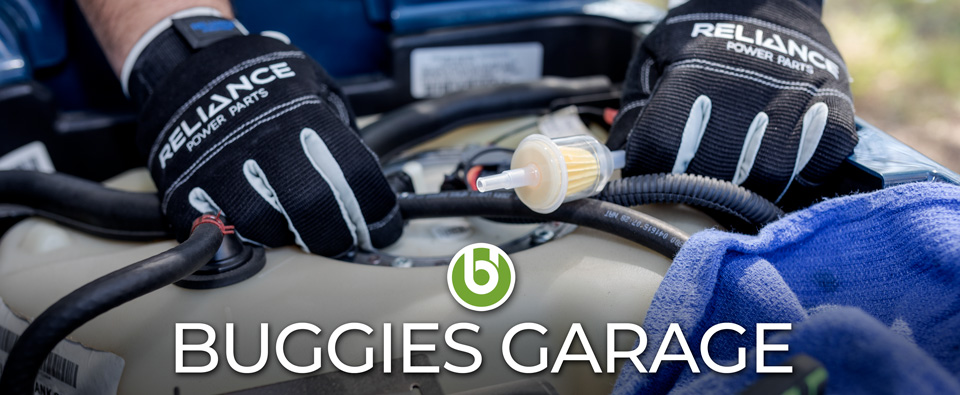You’ve planned the trip, booked the rooms, and plotted out a real adventure. You’re hauling luggage, water, and all the trail mix you can handle, but there’s still something missing from your perfect outing.
Whether it’s cruising through the course on a golf retreat or a highly-hyped hunting trip—the perfect getaway isn’t perfect without the right ride. Bringing your golf cart with you on a trip gives you added mobility on a campsite or in town. If you don’t want to miss out on more memories, you need to know how to transport a golf cart.
Knowing how to secure a golf cart on a trailer is crucial. With this quick guide, you’ll know what you’ll need, what size of trailer, and how to haul a golf cart in a few easy steps.
How much does a golf cart weigh?
The average E-Z-GO, Yamaha, or Club Car golf cart weight ranges from 800 and 1100 pounds.
It's a good question—how heavy is a golf cart? If you’re planning to haul your cart in a trailer, knowing the payload you can handle is key.
A cart with four or more seats will be larger, and the suspension will likely weigh more as well to account for more riders. The drivetrain, seating capacity, and power source can also affect the overall weight of your golf cart. Gas-powered and electric carts do have a noticeable difference in weight.
How much does an electric golf cart weigh?
Gas carts are typically the lightest models available. The fuel can add weight, but significantly less than the large batteries on 4+ passenger golf carts. This trend goes across brands, but here’s a look into the difference between how much an electric or gas golf cart weighs from the Club Car catalog:
2 passenger Club Car Villager: 48-volt Electric 975 lbs; Gas 675 lbs
Lifted 4 passenger Club Car Carryall: 48-volt Electric 1125 lbs; Gas 875 lbs
6 passenger Club Car Precedent Stretch PTV: HP Electric 1293 lbs; Gas 980 lbs
How wide is a golf cart?
The average golf cart dimensions for two-seat Yamahas, E-Z-GOs and Club Cars are around 92 x 48 x 75 inches for a standard 2 seat golf cart.
Since sizes vary, it’s important you check before purchasing or renting a trailer to haul a golf cart. You’ll want to be sure you have a bit of “wiggle room” between the trailer and the tires. This makes it easier to tie down, and keeps your wheels and tires from rubbing unnecessarily.
The best trailers for hauling golf carts
Learning how to tow a golf cart is easy if you’ve done the right research. Most riders say the ideal trailer for their cart is at least 5’ wide and 10’ long. This gives you a good bit of runway to park the cart comfortably and about six extra inches on each side.
If you don’t want to attach extra ramps and accessories to load up your golf cart, a swing-down ramp is a great option. This next step-by-step for easy golf cart towing features a swing-down ramp, and is one of the easiest ways to load your golf cart.
How to secure and tow a golf cart
Although in theory you can haul a golf cart in the bed of a truck, it’s not recommended. Using a trailer to transport your golf cart is safer.
Picking the right size trailer is important. Think of it this way: you want to measure twice, so you only have to load once. Also, choose a trailer that can tilt to allow your cart to be rolled on, with a ramp, or if necessary, buy, borrow or rent ramps to load your cart onto the trailer.
Ensure your towing vehicle has a ball hitch, and make sure it matches the coupler on your trailer. Remember: your vehicle’s payload capacity is crucial. Be sure to factor in the weight of the trailer and cart together before taking your golf cart on your trip.
With your towing vehicle set in park on a level surface, line the trailer’s coupling mechanism with the ball hitch of your vehicle and attach it. Secure the coupler with a pin or other mechanism according to the manufacturer’s instructions and put the trailer’s parking brake on. You’ll also need a wired harness that securely connects the tow vehicle to the trailer. Double check that your trailer is securely coupled BEFORE attempting to load your cart.
Depending on the type of trailer you have, prepare it for rolling or driving the cart gently up the ramp, or if your trailer has a hinge, directly up and into the trailer bed. Slow and steady is the name of the game here. If your trailer is hinged, make sure the cart is secured before you tip the trailer back to a horizontal position.
Now that your cart is on the trailer, it’s time to securely fasten it to the trailer. Use dependable straps and ratchets to fasten the cart to the trailer at the appropriate points according to the manufacturer’s instructions. (see diagram below for example)
With your cart strapped in, close your trailer and double check all trailer latches and pins to ensure that the trailer is locked in a level position and safely fastened to the towing vehicle. Double check your straps and ensure your cart is securely fastened to the trailer before you hit the road. Also follow manufacturer’s instructions for aftermarket parts and accessories when it comes to trailering – some accessories may need to be removed, or have a recommended maximum MPH.
When it comes to hauling your golf cart, safety is number one. Don’t risk your ride, or other people’s safety, by driving recklessly.
Hauling with your golf cart
Now that you know how to haul your golf cart, maybe you’re wondering if you can put a hitch on a golf cart itself to tow trailers: we’ve got good news!
If you’re out working, hauling brush, firewood, or any other heavy loads, a trailer for your PTV is a great resource. With the same ball hitch and easy installation, PTV users can add utility and versatility to their carts in one simple install. Find the best golf cart trailers available here.
DISCLAIMER
The information provided on Buggies Garage is intended for general informational and entertainment purposes. While our goal is to provide content that is valuable, Buggies Garage makes no representations or warranties of any kind, express or implied, with respect to the website or to the accuracy, completeness, or reliability of information contained on the website. Buggies makes no representations or warranties and assumes no responsibly with respect to third party products on the site. If you choose to engage in activities or take actions based on information posted here, you do so at your own risk, and Buggies Unlimited, Nivel Inc., or any associated companies assume no liability whatsoever.







